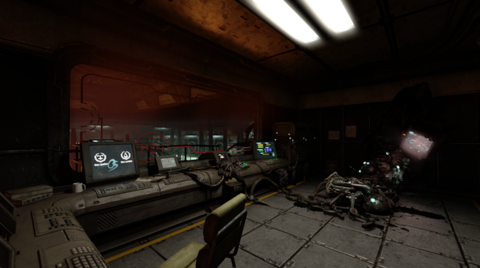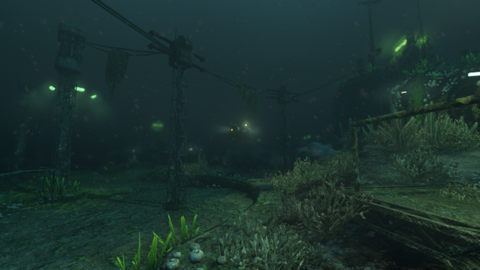While SOMA may have been dubbed a spiritual successor to the terrifying Amnesia: The Dark Descent, it would be reductive to simply call it a ‘science-fiction Amnesia’. For all its foreboding dread and ghastly creatures that go bump in the night, SOMA is driven more by an enigmatic narrative than any chilling moments of bloodcurdling terror.
It’s a sophisticated and thoughtful game, with some grand, exciting, and frankly strange ideas, that proves to be a welcome sign of maturation for developer Frictional Games. It’s clear the Swedish developer isn't content to simply revisit well-trodden ground with another haunted house filled with ghouls and Lovecraftian horror, but instead eager to forge forward with something unpredictable and fresh. SOMA may not routinely rouse a quickened heartbeat, or cause beads of sweat to trickle down your forehead as regularly as Frictional's previous work, but it’s also all the better for it.
Plunging deep into the murky depths below, your time with SOMA is spent in the water-logged boots of Simon Jarrett. How he ended up on this derelict subterranean research facility is just one of SOMA’s many mysteries; gradually revealed over the course of a story-driven experience that never stopped surprising me.
The amount of high quality dialogue (in terms of both voice acting and writing), is one such delightful revelation, especially coming off the back of Frictional’s decidedly less garrulous work. Simon is certainly the talkative type, and though you may be trapped aboard a rotting undersea hulk, signs of life have not diminished entirely within these corroded metal halls just yet. Fairly early on you meet a woman named Catherine who keeps in semi-regular contact with you throughout the game. She represents a familiar voice in times of peril, but there’s also a sense of unease inherent in never quite knowing her true intentions. Nevertheless, the snappy back-and-forth between the two, and their budding relationship, forms the crux of SOMA’s storytelling, which meshes some surprisingly natural dark humour with more dramatic confrontations, and profound questions of both an ethical and philosophical nature.

Consciousness, suicide, the way we perceive our reality, and how we fit into the world are themes explored and handled with nuance throughout, displaying sympathy for those in need, and exhibiting the gallantry to question some of SOMA’s more outlandish science. How deep you want to tumble down this rabbit hole is entirely up to you, however. Simon and Catherine’s journey is deliberately-paced, ingraining a sense of urgency and momentum into proceedings that keeps you eagerly moving from moment to moment, no matter how ominous the path ahead may seem. But there are also palette cleansers, too, where you’re free to explore an environment and possibly uncover just what the hell happened here.
A lot of SOMA’s horror arises from these instances; from the things that you don’t see. Where you come across grotesque scenes of things gone awry, and your imagination is free to run wild. Environmental details might fill in some of the blanks, and any corpses you find can be interacted with to reveal the final few seconds of a person’s life, lending SOMA’s irregular style of audio logs a sense of weight and intrigue. Notes scrawled on bits of paper strewn across someone’s desk may offer some insight, while most computers carry a few tidbits of backstory and information, if you’re willing to look.
Most of this is ancillary to the overarching narrative, but it feeds into a feeling that this facility was once bustling and full of life. A place worth living in, and thus a world worth building. It’s here where Frictional’s love of interactivity comes to life, as you grab, pick up and move objects, manually slide open doors, and pull down on levers until they clunk into place. SOMA’s retro-futuristic aesthetic lends functionality to these mechanics, making your presence within this world feel tangible. Computers breathe into life with a digital clatter and the whirring of fans, and SOMA’s various puzzles usually revolve around simply interacting and manipulating these various machines, gears, and clunky hardware. Again, it all helps to ground you in this world, where puzzles and story are intertwined to make gameplay and narrative feel like one cohesive whole, rather than separate entities. This breaks SOMA free from the shackles of Frictional’s past. Where Amnesia found a predictable rhythm of running, hiding, and then solving puzzles, SOMA’s progression feels more natural due to the underlying story seamlessly tying everything together.

If it falters in any way, it’s when you begin to resemble a less-murderous Isaac Clarke, with objectives regularly tasking you to fix things in order to pave the way forward. But even in these moments, when it teeters mightily close to the edge of predictability, it rarely feels like you’re doing the exact same thing twice. There’s always some variable or twist, and in SOMA's best moments, simply re-routing power may present a moral quandary or two to gnaw at your conscience.
Of course, there are still those occasions when you’re cowering in a corner; where the horror manifests itself in the hideous creatures that stalk and pursue you. It’s in these moments of isolation where the sound design really comes to life: all menacing growls, piercing shrieks, and something scurrying in the vents above. As ever, the fear of the unknown is often more terrifying than the blunt reality of coming face-to-face with your pursuer. Skulking the claustrophobic corridors of Pathos-II can be a test of your nerves. Whatever went wrong on this facility certainly left its mark, and the sense of dread is pervasive; etched into every nook and cranny.
"The fear of the unknown is often more terrifying than the blunt reality of coming face-to-face with your pursuer."
Biomechanical growths cover the walls like an aggressive cancer, covered in barnacles and dripping with a thick, black substance. A similar affliction seems to have affected the semi-organic creatures that lurk in the shadows. From your first encounter with the bulbous and lumbering brute near the game’s outset, to a relentless aggressor in a decaying diving suit, SOMA’s enemy encounters may be few and far between, but they’re certainly memorable--if only for their forlorn visual design. No two creatures are alike, and figuring out how they act and react to your presence forms the basis of these unsettling confrontations.
I found most of these interactions to be rather tedious affairs, however. As defenceless as you are, crouching and moving slowly proves to be the most effective tactic against these foes. When I was told not to look at one creature, I simply moved backwards. Meanwhile, a blind enemy who only reacted to sound merely made me especially careful not to bump into anything. These moments feel necessary to provide some adversity, and put a face to all the blinking lights and malfunctioning steam pipes, but I found myself clambering to get back to the story.

The same rings true when you venture outside into the deep blue, where sound is muted, the sea floor is awash with strands of seaweed, and the rotting husks of disused metal and decomposing facilities. Sea life is the only thing still alive out here, as crabs scatter past your feet, and curious fish circle overhead. A sunken submarine may inspire awe, but I found these sea walks to be dull, plodding affairs. Despite appearances, they’re incredibly linear, shuffling you along from point A to point B with nothing all that interesting to see in between.
These missteps of tedium shine a light on just how incredibly assured SOMA is elsewhere. I came in expecting something similar to Amnesia, just in a terrifying new location, but what I found is an intelligent game that forced me to think and contemplate ideas as only the best sci-fi is capable of doing. It may not stir the hordes of wailing YouTubers looking for the next best haunted house, but SOMA succeeds at crafting something much more meaningful in a genre that’s deserving of more than just simple jump scares.






